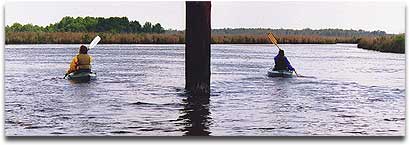
With about 29,000 acres, Fishing Bay WMA is the the state's largest wildlife management area and largest parcel of publicly owned tidal wetlands in Maryland. Large expanses of tidal marshes dominate eighty percent of this WMA, located adjacent to Blackwater National Wildlife Refuge. in southeastern Dorchester County. The property is dotted with small islands of lowland loblolly pines and mixed hardwoods.
What To See
Both the native white-tailed deer and the Asian sika deer can be found grazing on wetland plants. Muskrats and the exotic South American nutria compete for habitat. Nutria is a large rodent whose voracious appetite for marsh plants threatens this fragile ecosystem. Bald eagles, osprey, bobwhite quail, waterfowl and shorebirds, including the secretive black rail, are abundant.
What To Do
Listen for the bugling and whistling of the sika deer stags from September through December. Mallards and black ducks are abundant on the inland ponds, while the best bet for bagging diving ducks, like scaup, is on the bays and river shoreline. Canada geese can be found on the marsh and in the open water. Fur trapping is offered by yearly lease. Saltwater fishing and crabbing are excellent.
Area Regulations
- Use of Fishing Bay WMA is generally permitted seven days a week throughout the year.
- Hunting is allowed in accordance with open seasons and shooting hours.
- All State and Federal Hunting Laws and Regulations are applicable.
- Trapping is by permit only. Trapping bids are available in September and units are awarded in October. Call the LeCompte WMA office for further information.
- No motorized vehicles are allowed on trails.
- Access via 12 parking areas and 6 water access facilities.
- Public boat ramps provide two additional water access facilities with parking areas
- Camping is prohibited; except for educational groups on Guinea Island with a permit.
Non-hunting Users Guide
- Non-hunting visitors are welcome.
- Be aware of open hunting seasons and visit accordingly.
- Season dates available in newspapers, on the Internet, and at some area stores.
- Trails are maintained but not actively marked.
- Expect wet footing most of the year
- Biting insects can be abundant in warmer months.

Special Areas
- Two sections of marsh are open for nutria hunting throughout trapping season (Unit H and O).
See map for the locations of these two areas.
- Two watertrails have been designated for experienced paddlers to view wildlife and enjoy the marsh ecosystems.
Site Management Goals
Prescribed fires are used during the winter months on both marsh and woodlands to improve plant and wildlife diversity. Be aware of these activities before entering the area during January to April.
 Directions
Directions
From the Bay Bridge, take U.S. Route 50 east to Cambridge. Follow Bucktown Road south to Bestpitch Ferry Road. Proceed south crossing the Transquaking River to the Fishing Bay entrance. Other sections of the area can be reached by Griffith's Neck Road, Maple Dam Road and Elliot Island Road. Public boat launching facilities at Bestpitch, Elliot Island and Shorter's Wharf are convenient to Fishing Bay. For additional information, contact the LeCompte Wildlife Office at (410) 376-3236.
 Fishing Bay WMA Maps
Fishing Bay WMA Maps
Kayak photo by Tom Darden
This area is a part of Maryland’s Department of Natural Resources public land system and is managed by the Wildlife and Heritage Service. The primary mission of the WMA system is to conserve and enhance wildlife populations and their respective habitats as well as to provide public recreational use of the State’s wildlife resources.
Eighty-five percent of the funding for Maryland's state wildlife programs comes from hunting license fees and a federal excise tax on sport hunting devices and ammunition. The federal aid funds are derived from the Federal Aid in Wildlife Restoration (or Pittman-Robertson) Fund, which sportsmen and women have been contributing to since 1937. Each state receives a share of the funds, which is administered by the U. S. Fish and Wildlife Service; these funds are used for wildlife conservation and hunter education programs, including the management of the WMA system.
Other sources of funds for land acquisition include Program Open Space Funding for Maryland's State and local parks and conservation areas, provided through The Department of Natural Resources' Program Open Space. Established in 1969, Program Open Space symbolizes Maryland's long-term commitment to conserving natural resources while providing exceptional outdoor recreation opportunities.